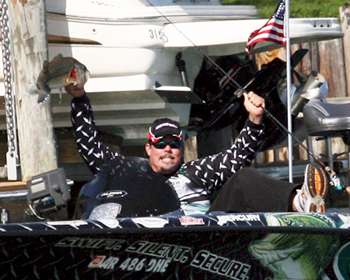
When Dean Rojas and Fred Roumbanis used hollow-bodied frogs to win tournaments during 2008 Elite Series season, the soft plastic swimming frog suddenly seemed to become a little less stylish. Be that as it may, Elite Series pro Chris Lane points out that Kermit's cousin can still get it done — particularly during late summer and early fall.
"We're getting into the time of the year when fish are going to be schooling up," says Lane. "When they're up in the grass, a soft plastic frog like a Gambler Cane Toad is going to be your best bet because they're just so weedless and you can throw them anywhere."
Heavy grass is certainly where the soft plastic frog can shine, but Lane explains that they can be equally dangerous in open water.
"You can use it anywhere, really," he says. "I've thrown it over open water, and I've thrown it right across the top of big grass mats. I've thrown it over deep water where grass is growing up off the bottom. The key is to put it where the fish are."
When deciding between a soft plastic frog and a hollow-bodied walking frog, he analyzes the activity level of the bass.
"I will always go with the solid plastic frog when the bass are chasing bait," Lane says. "The hollow-bodied frogs seem to perform better when bass are hanging under cover. If bass are schooling or chasing bait, a swimming frog will catch more bass."
Lane explains that when fishing the swimming frog, there's no need to wait to set the hook after the bass has taken the offering.
"When it comes to setting the hook, there's no room for waiting around," he says. "You don't have to wait two seconds like you do with a hollow-body frog — when they blow up on it they're usually going to have it engulfed."
Rod and line choice are extremely important when throwing a soft plastic frog.
"You need to use a heavy flipping stick with a high-speed reel," he says. "I like to use a 7 1/2-foot rod because it allows me to really zing the frog a long way and cover a lot of water." Lane spools his high-speed reel with 50-pound-test braided line.
The heavy braid and long rod may seem like overkill, but Lane points out that, given the ferocity of the strikes, bigger is better.
"You're going to be getting a ton of bites with a swimming frog this time of the year, so you want to make sure your equipment can meet the challenge," he explains. "The worst thing is to be getting all these bites and not have a rod or line strong enough to get them back to the boat."
When rigging the swimming frog, Lane uses Gambler's Double Trouble Toad Hook — a hook he designed specifically for fishing soft plastic frogs. As the name implies, the toad hook features a double hook and a weighted, screw-in head — an important addition according to Lane.
"I like to use a hook that has a weighted head," he points out. "I also prefer to use a corkscrew-wire on the head that allows me to screw the frog onto the hook as opposed to threading it up to the eye of the hook." The weight and screw-in head allow the frog to ride correctly on top of the water, rather than roll and twist when retrieved.
While the soft plastic frog is most often used as a surface bait, Lane also suggests using it as the trailer for a swim jig.
"You have to trim it a little bit, but it can be a phenomenal trailer on a swim jig," he says. "It just moves so much it's tough for a bass to pass it up."




